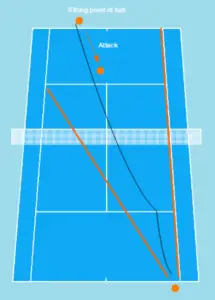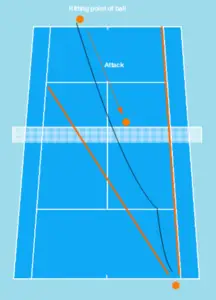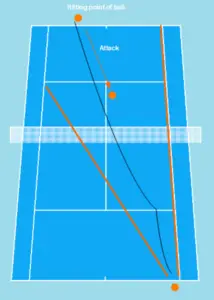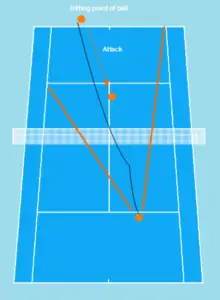Tennis passing shot
The perfect tennis passing shot as a beginner
The perfect tennis passing shot as a beginner
The opponent plays the tennis ball aggressively over the net and then moves forward to put you under pressure. Many tennis beginners get nervous in this situation and make a rash mistake, giving the point to the opponent.
This does not have to be the case, because a passing shot can be practiced. There are two possibilities: Either you play the tennis ball past the attacking tennis player or you deliberately play to the body or low in front of the opponent’s feet. Logically, it should not be a half-high ball inviting the opponent to win a point, but must be played in a well-placed manner.
Below we explain to tennis beginners the different situations and options of a perfect passing shot if the opponent attacks the net.
1. Passive net attack
The opponent is attacking the net but has hesitated slightly in advancing to the net or has had the idea of advancing to the net when you hit a relatively long ball. In this situation, he will often not make it to a promising position at the net in time, because he is still behind the T-line when you hit the tennis ball.
In this case, you should stay as calm as possible and play a well-placed topspin ball longline or cross, depending on whether the ball comes to your forehand or backhand side.
The speed plays a subordinate role, because the opponent is in a rather unfavorable position, so play the ball safely and a little precisely, not on the line but rather just in the direction of the line, past him or her.

2. Too aggressive net attack
The opponent attacks the net again but this time is too fast with his advance to the net and misses the best point to cover the whole field and make an appropriate split step. In this situation he will almost touch the edge of the net.
In this case, it is recommended to stay calm as always and, depending on whether the ball comes to your forehand or backhand side, play a topspin lob crosscourt over your opponent, because crosscourt is the longest for you.
The passing shot should definitely be played with topspin, so that the rushing back opponent has no chance to reach the fast bouncing tennis ball. Therefore, don’t be too passive with the lob, otherwise it may remain a lob attempt that becomes an invitation to a smash for your opponent.

3. Deep passing shot
The opponent attacks the net again and makes the split-step in a good position to cover the whole field. The attacking ball is also very well played that you really get into trouble.
In distress, an all-or-nothing shot often leads to a loss of points, so try to play the ball placed between the edge of the net and the opponent. The ball should not be set too high, otherwise the opponent will just advance and have an easy volley. The ball should be played low and not at all fast. You can play this shot both as a topspin and slice on the forehand or backhand side.
This situation is particularly unpleasant for the opponent, because in his aggressive position he will not like to let the tennis ball bounce and thus he will be forced to play a deep volley, i.e. under the edge of the net. The volley is therefore particularly unpleasant and often leads to your winning the point.

4. On the body-placed passing shot
The opponent attacks the net again but plays his own attack ball much too short and as a half invitation for you. The attacking ball is not played very well and you are already in the court.
In this situation you have all options, you can usually just play the tennis ball longline or cross with forehand or backhand past the opponent or you accept the invitation and play fast to the opponent’s body.
This option is not known as the fine English way, but it is a legitimate means to win the point. The advantage is obvious: you are already in a promising position and the opponent can react to a quick blow from you with difficulty or almost not at all. After that, the opponent is usually a little intimidated and will think twice about which shot he dares to take to the net again.
Please note that hitting towards the opponent’s body is an option, but please do not use it among friends in training, for example, as this can be misunderstood. In the decisive moment of a tennis match, however, it is definitely an option to consider. Please also do not use this option if your opponent realizes that his attacking ball was bad and already turns his back to the net – this would be gross unsportsmanlike conduct and definitely leads to unnecessary quarrels.

5. Typical passing shot mistakes and tips
Finally, three typical mistakes and tips to improve your passing stroke:
a) Make your decision early and stick to it
Many tennis beginners get irritated by the opponent rushing to the net, so that they change their mind shortly before the actual passing shot. This often leads to a hasty mistake. Therefore, make your decision depending on the situation early and then implement it as planned no matter what movements your opponent makes when running to the net.
b) Vary your passing strokes
Many tennis beginners always play the same passing shot. For example, when the opponent comes to the net, some beginners always play longline. By the third time at the latest, even the last opponent has understood this and will cover the longline side early to win the point. Therefore, vary your passing strokes so that you are not readable for your opponent.
c) Give the opponent the chance to make the mistake
Even with a well played attacking ball from your opponent and a good position at the net, your opponent has not automatically won the point. Even if you don’t hit your ball exactly where you want it, aim too far down the court instead of out of bounds. Your opponent will have to play at least one more volley or smash to win the point. And even there mistakes can happen – if there is no mistake accept the good attack of your opponent and concentrate again on the next point.

